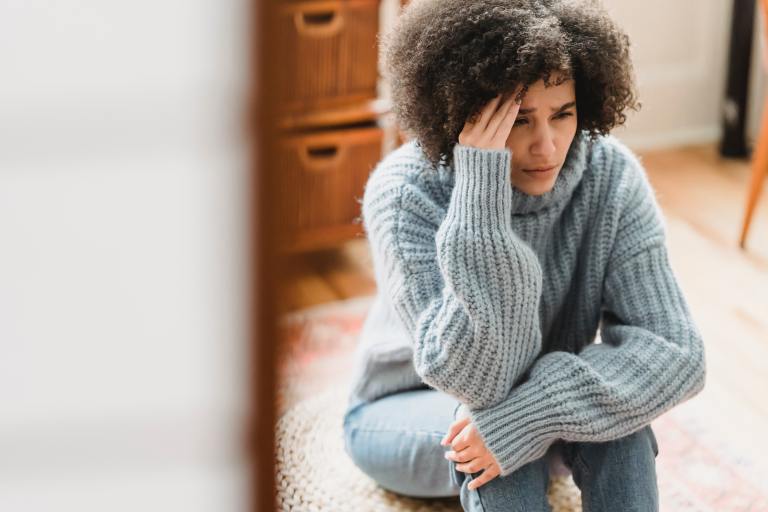Body Image: The Model Religion
A new book by Michelle Lelwica, Th. D. (Theology Doctorate), offers new insight into women's body blues. Lelwica's research has shown her that the female's goal of a perfect physique is dogmatic in nature and that the prospect of being thin and beautiful is equivalent to a degree of salvation and spiritual fulfillment,
By Amanda Bloom

It is almost a given that the modern-day female is unhappy with her body. Perhaps it is her thighs or her belly, her nose or her build. Whatever the imperfection, she is likely to devote a great deal of energy to worrying over the problem area and making efforts to change it throughout her lifetime.
A new book by Michelle Lelwica, Th. D. (Theology Doctorate), offers new insight into women’s body blues. Lelwica’s research has shown her that the female’s goal of a perfect physique is dogmatic in nature and that the prospect of being thin and beautiful is equivalent to a degree of salvation and spiritual fulfillment. In The Religion of Thinness, Lelwica traces our values of thinness and beauty all the way back to the first lady, Eve.
Lelwica was featured on MentorConnect, an online eating disorder mentoring community, in a teleconference this past December. Shannon Cutts, the founder of MentorConnect, interviewed Lelwica about her book and both shared their insights into eating disorder recovery. Cutts first asked Lelwica if she felt that images in the media were responsible for Lelwica’s bulimia earlier in life. Lelwica said no – the root of her eating disorder was an inability to cope with feelings of pain and suffering, yet images in the media did serve as a powerful trigger.
“I used to read Seventeen magazine like a bible,” Lelwica said. “And I had no critical consciousness; I had no real ability to look at what the messages were. And I made no connection whatsoever between the kind of profound self-loathing I had for my body and the images that I was studying all the time.”?? Lelwica asserts that the way women and men are portrayed in print and on the screen goes beyond entertainment and that there is an underlying message in their bodies and the roles they play. She said that the images speak to us on an existential level; they offer “an answer before the question.”
??”So many of us know that of course [the images] are computerized,” she said. “Many of the women in magazines aren’t even real anymore…We can kind of know that intellectually, even really strongly intellectually, but those images still get under our skin…They’re speaking to a different part of us, they’re not speaking to our intellect. They’re speaking to the part of us that really is looking for something, the part of us that wants to feel like there’s some point to it all, that we have something to strive after or that we have a meaning or a purpose.
“They tell us, ‘This is what it looks like, this is what you could be,’ before we’ve even been allowed to explore whatever unpleasant feelings or whatever emptiness or anxiety or stress or edginess or depression, whatever it is that’s going on inside of us,” Lelwica continued. “We don’t have to deal with it if we could just look at those pictures. They kind of tell you right away before you even have to ask the question. So in that sense, they kind of preempt the spiritual journey we need to have to transform that pain.”
??In a follow-up email interview, I asked Lelwica what she felt these images are specifically saying. ??”I think one of the most repetitive and ubiquitous messages women receive from mainstream/popular media images of women is that their happiness depends on being thin, and that thinness is also the ticket to success in other areas, such as romance, beauty, career, health,” she said. “If I had to give a ‘conversation bubble’ to any given model in an advertisement, I would have her saying something like: ‘Look how pretty, I mean slim, I mean healthy, I mean thin, I mean happy, I mean slender I am. Surely if you buy this product you will be pretty-happy-healthy-thin too. And surely being happy, healthy, and pretty are impossible without being skinny!'”
Lelwica and Cutts touched on the fact that the desire to change our bodies fuels a number of industries – cosmetics, weight loss, clothing, cosmetic surgery, etc. As a part of their “Love Your Body” Campaign, the National Organization for Women created “The ABCs and Ds of Commercial Images of Women”, a slide presentation that shows how advertisements and the media showcase and “enforce” unrealistic beauty standards. The presentation goes quite deep in the dissection of advertisements and illustrates how these images fuel both commerce and low self-esteem.
It was during her graduate studies at Harvard Divinity School that Lelwica began to uncover the deep root of bodily shame as she researched the works of early theologians, specifically within historical Christianity. ??”The theme kept on coming up again and again of women’s bodies being shameful,” she said to Cutts. “They’re the sign of women’s inferiority, their weakness, their intellectual capabilities.” Lelwica spoke about how early church fathers often blamed Eve for bringing sin into the world, for leading men into temptation, and causing the downfall of humankind. Lelwica found a powerful symbolism in the story of Eve: “She eats,” Lelwica said, “and it is her eating that brings evil into the world…There’s a suggestion that women fail to control their bodies – Eve failed to control her appetite – that is not the author’s intention, but the symbolism is still very relevant for women today.” Lelwica described this discovery as an “A-ha!” moment in understanding her own eating disorder. She was able to see her self-loathing as part of a cultural and historical phenomenon and as a tradition passed down from generation to generation.
“It’s not about individual women,” she said. “We are carrying in our bodies this whole legacy that is much bigger than us. And we need to wake up and do what we can in our own ways, find our own ways to develop a kind of resistance and a way of transforming that whole narrative of women’s uncontrollable, unruly, sinful bodies and find ways to feel empowered in our bodies.”
I asked Lelwica what she would say to people who might disregard her theories on the deep implications of images in the media and the value of thinness in our society. She said that the largest indication that these ideals are damaging is the fact that the vast majority of women think there is something wrong with their bodies. “We are culturally conditioned to want a ‘better’ (read: thinner) body and to assume that the bodies we are born with are not okay,” she said. “The media is not the only factor persuading us that our bodies need to be fixed, but it is certainly one of the most widespread and thus powerful influences on our thinking and our relationships to our bodies.”??
“I start from the assumption that we are not born wishing we were thinner,” said Lelwica, “rather, this desire is learned.” ??For more information on The Religion of Thinness and Michelle Lelwica, visit the website for Religion of Thinness.![]()




